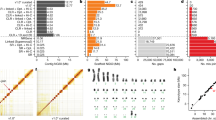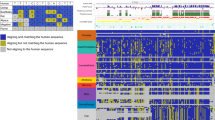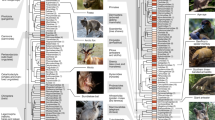Key Points
-
Distant species comparisons reveal core vertebrate sequences that often function as enhancers.
-
Sequences that are conserved across long evolutionary distances often occur in clusters.
-
Distant species comparisons enable the analysis of a limited subset of genes in the human genome. These genes often have pivotal roles in embryonic development.
-
Comparisons of multiple primate species enable the identification of primate-specific conserved sequences.
-
Comparisons between human and chimpanzee sequences reveal sequence changes that underlie human-specific adaptations.
-
The sequences of many additional vertebrate genomes, as well as extensive information about human sequence polymorphisms, will become available in the near future, which could significantly change the approach to comparative genomics.
Abstract
Annotators of the human genome are increasingly exploiting comparisons with genomes at both the distal and proximal evolutionary edges of the vertebrate tree. Despite the sequence similarity between primates, comparisons among members of this clade are beginning to identify primate- as well as human-specific functional elements. At the distal evolutionary extreme, comparing the human genome to that of non-mammal vertebrates such as fish has proved to be a powerful filter to prioritize sequences that most probably have significant functional activity in all vertebrates.
This is a preview of subscription content, access via your institution
Access options
Subscribe to this journal
Receive 12 print issues and online access
$189.00 per year
only $15.75 per issue
Buy this article
- Purchase on Springer Link
- Instant access to full article PDF
Prices may be subject to local taxes which are calculated during checkout


Similar content being viewed by others
References
Homer . The Odissey Ch. 12 (Signet Classic, New York, 1999).
Nobrega, M. A. & Pennacchio, L. A. Comparative genomic analysis as a tool for biological discovery. J. Physiol. 554, 31–39 (2004).
Pennacchio, L. A. & Rubin, E. M. Comparative genomic tools and databases: providing insights into the human genome. J. Clin. Invest. 111, 1099–1106 (2003).
Frazer, K. A. et al. Evolutionarily conserved sequences on human chromosome 21. Genome Res. 11, 1651–1659 (2001).
Loots, G. G. et al. Identification of a coordinate regulator of interleukins 4, 13, and 5 by cross-species sequence comparisons. Science 288, 136–140 (2000).
Pennacchio, L. A. et al. An apolipoprotein influencing triglycerides in humans and mice revealed by comparative sequencing. Science 294, 169–173 (2001).
Kellis, M., Patterson, N., Endrizzi, M., Birren, B. & Lander, E. S. Sequencing and comparison of yeast species to identify genes and regulatory elements. Nature 423, 241–254 (2003). Paradigmatic example of the power of comparisons of multiple, related genomes to identify functional sequence in a genome.
Thomas, J. W. et al. Comparative analyses of multi-species sequences from targeted genomic regions. Nature 424, 788–793 (2003).
Boffelli, D. et al. Phylogenetic shadowing of primate sequences to find functional regions of the human genome. Science 299, 1391–1394 (2003). The first paper to describe the use of comparisons of multiple, closely related primates to identify primate-specific conserved sequences.
Hardison, R. C. et al. Covariation in frequencies of substitution, deletion, transposition, and recombination during eutherian evolution. Genome Res. 13, 13–26 (2003).
Hardison, R. C. Comparative genomics. PLoS Biol. 1, E58 (2003).
Mouse Genome Sequencing Consortium. Initial sequencing and comparative analysis of the mouse genome. Nature 420, 520–562 (2002).
Schwartz, S. et al. Human–mouse alignments with BLASTZ. Genome Res. 13, 103–107 (2003).
Pennacchio, L. A., Baroukh, N. & Rubin, E. M. in Symposia on Quantitative Biology: The Genome of Homo sapiens (Cold Spring Harbor Press, Cold Spring Harbor, in the press).
Elnitski, L. et al. Distinguishing regulatory DNA from neutral sites. Genome Res. 13, 64–72 (2003).
Brenner, S. et al. Characterization of the pufferfish (Fugu) genome as a compact model vertebrate genome. Nature 366, 265–268 (1993).
Aparicio, S. et al. Whole-genome shotgun assembly and analysis of the genome of Fugu rubripes. Science 297, 1301–1310 (2002).
Arnone, M. I. & Davidson, E. H. The hardwiring of development: organization and function of genomic regulatory systems. Development 124, 1851–1864 (1997).
Aparicio, S. et al. Detecting conserved regulatory elements with the model genome of the Japanese puffer fish, Fugu rubripes. Proc. Natl Acad. Sci. USA 92, 1684–1688 (1995). Demonstrates that human– F. rubripes comparisons detect conserved non-coding sequences that, once tested in in vivo assays, correspond to enhancers.
Nobrega, M. A., Ovcharenko, I., Afzal, V. & Rubin, E. M. Scanning human gene deserts for long-range enhancers. Science 302, 413 (2003).
Lettice, L. A. et al. A long-range Shh enhancer regulates expression in the developing limb and fin and is associated with preaxial polydactyly. Hum. Mol. Genet. 12, 1725–1735 (2003). Demonstrates that sequence variation in cis -regulatory elements at near-megabase distances can result in phenotypic variation.
Kleinjan, D. J. & van Heyningen, V. Position effect in human genetic disease. Hum. Mol. Genet. 7, 1611–1618 (1998).
de Kok, Y. J. et al. Identification of a hot spot for microdeletions in patients with X-linked deafness type 3 (DFN3) 900 kb proximal to the DFN3 gene POU3F4. Hum. Mol. Genet. 5, 1229–1235 (1996).
Zerucha, T. et al. A highly conserved enhancer in the Dlx5/Dlx6 intergenic region is the site of cross-regulatory interactions between Dlx genes in the embryonic forebrain. J. Neurosci. 20, 709–721 (2000).
Blader, P., Plessy, C. & Strahle, U. Multiple regulatory elements with spatially and temporally distinct activities control neurogenin1 expression in primary neurons of the zebrafish embryo. Mech. Dev. 120, 211–218 (2003).
Dickmeis, T. et al. Expression profiling and comparative genomics identify a conserved regulatory region controlling midline expression in the zebrafish embryo. Genome Res. 14, 228–238 (2004).
Goode, D. K., Snell, P. K. & Elgar, G. K. Comparative analysis of vertebrate Shh genes identifies novel conserved non-coding sequence. Mamm. Genome 14, 192–201 (2003).
Kimura-Yoshida, C. et al. Characterization of the pufferfish Otx2 cis-regulators reveals evolutionarily conserved genetic mechanisms for vertebrate head specification. Development 131, 57–71 (2004).
Barton, L. M. et al. Regulation of the stem cell leukemia (SCL) gene: a tale of two fishes. Proc. Natl Acad. Sci. USA 98, 6747–6752 (2001).
Lien, C. L., McAnally, J., Richardson, J. A. & Olson, E. N. Cardiac-specific activity of an Nkx2-5 enhancer requires an evolutionarily conserved Smad binding site. Dev. Biol. 244, 257–266 (2002).
Ghanem, N. et al. Regulatory roles of conserved intergenic domains in vertebrate Dlx bigene clusters. Genome Res. 13, 533–543 (2003).
Sharpe, J. et al. Identification of Sonic hedgehog as a candidate gene responsible for the polydactylous mouse mutant Sasquatch. Curr. Biol. 9, 97–100 (1999).
Lettice, L. A. et al. Disruption of a long-range cis-acting regulator for Shh causes preaxial polydactyly. Proc. Natl Acad. Sci. USA 99, 7548–7553 (2002).
Berman, B. P. et al. Exploiting transcription factor binding site clustering to identify cis-regulatory modules involved in pattern formation in the Drosophila genome. Proc. Natl Acad. Sci. USA 99, 757–762 (2002).
Markstein, M., Markstein, P., Markstein, V. & Levine, M. S. Genome-wide analysis of clustered Dorsal binding sites identifies putative target genes in the Drosophila embryo. Proc. Natl Acad. Sci. USA 99, 763–768 (2002).
Chiang, D. Y., Moses, A. M., Kellis, M., Lander, E. S. & Eisen, M. B. Phylogenetically and spatially conserved word pairs associated with gene-expression changes in yeasts. Genome Biol. 4, R43 (2003).
Moses, A. M., Chiang, D. Y., Kellis, M., Lander, E. S. & Eisen, M. B. Position specific variation in the rate of evolution in transcription factor binding sites. BMC Evol. Biol. 3, 19 (2003).
Anand, S. et al. Divergence of Hoxc8 early enhancer parallels diverged axial morphologies between mammals and fishes. Proc. Natl Acad. Sci. USA 100, 15666–15669 (2003).
Mainguy, G. et al. A position-dependent organisation of retinoid response elements is conserved in the vertebrate Hox clusters. Trends Genet. 19, 476–479 (2003).
Erwin, D. H. & Davidson, E. H. The last common bilaterian ancestor. Development 129, 3021–3032 (2002). One of the many insightful studies by this group that characterizes genetic regulatory networks, aspects of which are shared by all bilaterians, in contrast to other aspects that probably evolved later, in subgroups of species.
Davidson, E. H. et al. A genomic regulatory network for development. Science 295, 1669–1678 (2002).
Bejerano, G. et al. Ultra-conserved elements in the human genome. Science 6 May 2004 (doi:10.1126/science.1098119). Seminal study first reporting the characterization of ultra-conserved elements in mammalian genomes.
Dodou, E., Xu, S. M. & Black, B. L. mef2c is activated directly by myogenic basic helix-loop-helix proteins during skeletal muscle development in vivo. Mech. Dev. 120, 1021–1032 (2003).
Ludwig, M. Z., Bergman, C., Patel, N. H. & Kreitman, M. Evidence for stabilizing selection in a eukaryotic enhancer element. Nature 403, 564–567 (2000). First convincing demonstration of the role of balancing selection in maintaining an invariant function in enhancers with diverging sequence.
Takahashi, H., Mitani, Y., Satoh, G. & Satoh, N. Evolutionary alterations of the minimal promoter for notochord-specific Brachyury expression in ascidian embryos. Development 126, 3725–3734 (1999).
Lynch, M. & Conery, J. S. The evolutionary fate and consequences of duplicate genes. Science 290, 1151–1155 (2000).
Johnson, M. E. et al. Positive selection of a gene family during the emergence of humans and African apes. Nature 413, 514–519 (2001).
Lawn, R. M. et al. The recurring evolution of lipoprotein(a). Insights from cloning of hedgehog apolipoprotein(a). J. Biol. Chem. 270, 24004–24009 (1995).
Boffelli, D., Cheng, J. F. & Rubin, E. M. Convergent evolution in primates and an insectivore. Genomics 83, 19–23 (2004).
King, M. C. & Wilson, A. C. Evolution at two levels in humans and chimpanzees. Science 188, 107–116 (1975).
Yang, Z. & Nielsen, R. Estimating synonymous and nonsynonymous substitution rates under realistic evolutionary models. Mol. Biol. Evol. 17, 32–43 (2000).
Yang, Z. PAML: a program package for phylogenetic analysis by maximum likelihood. Comput. Appl. Biosci. 13, 555–556 (1997).
Hughes, A. L. & Yeager, M. Natural selection at major histocompatibility complex loci of vertebrates. Annu. Rev. Genet. 32, 415–435 (1998).
Swanson, W. J., Yang, Z., Wolfner, M. F. & Aquadro, C. F. Positive Darwinian selection drives the evolution of several female reproductive proteins in mammals. Proc. Natl Acad. Sci. USA 98, 2509–2514 (2001).
Swanson, W. J. & Vacquier, V. D. The rapid evolution of reproductive proteins. Nature Rev. Genet. 3, 137–144 (2002).
Wyckoff, G. J., Wang, W. & Wu, C. I. Rapid evolution of male reproductive genes in the descent of man. Nature 403, 304–309 (2000).
Clark, A. G., Begun, D. J. & Prout, T. Female × male interactions in Drosophila sperm competition. Science 283, 217–220 (1999).
Goldberg, A. et al. Adaptive evolution of cytochrome c oxidase subunit VIII in anthropoid primates. Proc. Natl Acad. Sci. USA 100, 5873–5878 (2003).
Enard, W. et al. Molecular evolution of FOXP2, a gene involved in speech and language. Nature 418, 869–872 (2002). Elegant identification of a gene suspected to be involved in the development of speech undergoing positive selection in the human lineage.
Huttley, G. A. et al. Adaptive evolution of the tumour suppressor BRCA1 in humans and chimpanzees. Australian Breast Cancer Family Study. Nature Genet. 25, 410–413 (2000).
Stedman, H. H. et al. Myosin gene mutation correlates with anatomical changes in the human lineage. Nature 428, 415–418 (2004).
Clark, A. G. et al. Inferring nonneutral evolution from human–chimp–mouse orthologous gene trios. Science 302, 1960–1963 (2003).
Zhang, J., Zhang, Y. P. & Rosenberg, H. F. Adaptive evolution of a duplicated pancreatic ribonuclease gene in a leaf-eating monkey. Nature Genet. 30, 411–415 (2002).
Fleming, M. A., Potter, J. D., Ramirez, C. J., Ostrander, G. K. & Ostrander, E. A. Understanding missense mutations in the BRCA1 gene: an evolutionary approach. Proc. Natl Acad. Sci. USA 100, 1151–1156 (2003).
Wasserman, W. W. & Sandelin, A. Applied bioinformatics for the identification of regulatory elemements. Nature Rev. Genet. 5, 276–287 (2004).
Gumucio, D. L. et al. Differential phylogenetic footprinting as a means to identify base changes responsible for recruitment of the anthropoid γ-gene to a fetal expression pattern. J. Biol. Chem. 269, 15371–15380 (1994).
Rockman, M. V., Hahn, M. W., Soranzo, N., Goldstein, D. B. & Wray, G. A. Positive selection on a human-specific transcription factor binding site regulating IL4 expression. Curr. Biol. 13, 2118–2123 (2003).
Frazer, K. A. et al. Genomic DNA insertions and deletions occur frequently between humans and nonhuman primates. Genome Res. 13, 341–346 (2003).
Locke, D. P. et al. Large-scale variation among human and great ape genomes determined by array comparative genomic hybridization. Genome Res. 13, 347–357 (2003).
Yu, N. et al. Larger genetic differences within Africans than between Africans and Eurasians. Genetics 161, 269–274 (2002).
Collins, F. S., Green, E. D., Guttmacher, A. E. & Guyer, M. S. A vision for the future of genomics research. Nature 422, 835–847 (2003).
Dermitzakis, E. T. et al. Evolutionary discrimination of mammalian conserved non-genic sequences (CNGs). Science 302, 1033–1035 (2003).
Cooper, G. M. et al. Quantitative estimates of sequence divergence for comparative analyses of mammalian genomes. Genome Res. 13, 813–820 (2003).
Margulies, E. H., Blanchette, M., NISC Comparative Sequencing Program, Haussler, D. & Green, E. D. Identification and characterization of multi-species conserved sequences. Genome Res. 13, 2507–2518 (2003).
Frazer, K. A. et al. Noncoding sequences conserved in a limited number of mammals in the SIM2 interval are frequently functional. Genome Res. 14, 367–372 (2004).
Carroll, S. B. Endless forms: the evolution of gene regulation and morphological diversity. Cell 101, 577–580 (2000).
Fay, J. C., Wyckoff, G. J. & Wu, C. I. Testing the neutral theory of molecular evolution with genomic data from Drosophila. Nature 415, 1024–1026 (2002).
Smith, J. M. & Haigh, J. The hitch-hiking effect of a favourable gene. Genet. Res. 23, 23–35 (1974).
Gellner, K. & Brenner, S. Analysis of 148 kb of genomic DNA around the wnt1 locus of Fugu rubripes. Genome Res. 9, 251–258 (1999).
Muller, F. et al. Intronic enhancers control expression of zebrafish sonic hedgehog in floor plate and notochord. Development 126, 2103–2116 (1999).
Bagheri-Fam, S., Ferraz, C., Demaille, J., Scherer, G. & Pfeifer, D. Comparative genomics of the SOX9 region in human and Fugu rubripes: conservation of short regulatory sequence elements within large intergenic regions. Genomics 78, 73–82 (2001).
Hans, S. & Campos-Ortega, J. A. On the organisation of the regulatory region of the zebrafish δD gene. Development 129, 4773–4784 (2002).
Santini, S., Boore, J. L. & Meyer, A. Evolutionary conservation of regulatory elements in vertebrate Hox gene clusters. Genome Res. 13, 1111–1122 (2003).
Spitz, F., Gonzalez, F. & Duboule, D. A global control region defines a chromosomal regulatory landscape containing the HoxD cluster. Cell 113, 405–417 (2003). One of the most elegant examples of the application of distant vertebrate sequence comparisons aiding the sifting of large genomic intervals for functional sequences.
Griffin, C., Kleinjan, D. A., Doe, B. & van Heyningen, V. New 3′ elements control Pax6 expression in the developing pretectum, neural retina and olfactory region. Mech. Dev. 112, 89–100 (2002).
Eggers, J. H., Stock, M., Fliegauf, M., Vonderstrass, B. & Otto, F. Genomic characterization of the RUNX2 gene of Fugu rubripes. Gene 291, 159–167 (2002).
Acknowledgements
We would like to thank Len Pennacchio and members of the Rubin laboratory for useful discussions. Research was conducted at the E. O. Lawrence Berkeley National Laboratory, with support by a grant from the Programs for Genomic Application, NHLBI, and performed under a Department of Energy contract, University of California, USA.
Author information
Authors and Affiliations
Corresponding author
Ethics declarations
Competing interests
The authors declare no competing financial interests.
Related links
Glossary
- NEUTRAL RATE
-
Genetic variation that does not affect the fitness of the organism is not subject to selection and evolves at the neutral rate.
- GENE DESERTS
-
Gene-poor regions in the genome that are larger than 500 kb. Gene deserts often contain sporadic evidence of transcription.
- VISTA
-
A powerful tool for aligning the genome and visualizing the location of conserved sequences (see online links box).
- PHYLOGENETIC SHADOWING
-
An approach that combines comparisons of sequences from multiple, closely related species with a molecular phylogenetic model of sequence evolution to identify significantly conserved elements.
- POSITIVE SELECTION
-
A sequence change in a species that results in increased fitness is subject to positive selection. As a consequence, the change normally becomes fixed, leading to adaptive evolution of that species.
Rights and permissions
About this article
Cite this article
Boffelli, D., Nobrega, M. & Rubin, E. Comparative genomics at the vertebrate extremes. Nat Rev Genet 5, 456–465 (2004). https://doi.org/10.1038/nrg1350
Issue Date:
DOI: https://doi.org/10.1038/nrg1350
This article is cited by
-
Functional and structural basis of extreme conservation in vertebrate 5′ untranslated regions
Nature Genetics (2021)
-
Human protein-RNA interaction network is highly stable across mammals
BMC Genomics (2019)
-
Long non-coding RNA in stem cell pluripotency and lineage commitment: functions and evolutionary conservation
Cellular and Molecular Life Sciences (2019)
-
Functionally conserved enhancers with divergent sequences in distant vertebrates
BMC Genomics (2015)
-
Regulation of MEIS1 by distal enhancer elements in acute leukemia
Leukemia (2014)



